Preventing Poinsettia Problems (PPP)
I’ve been writing this newsletter for about five years now, and around Week 25 of each year I start covering poinsettia production challenges in great depth. Most of you have a love/hate relationship with the crop, because for many of you the potential challenges are great … but the subsequent payoff is not so great. Yes, some have developed business models and strategies that are quite profitable, but for many growers the margins on the #1 holiday plant are slim.
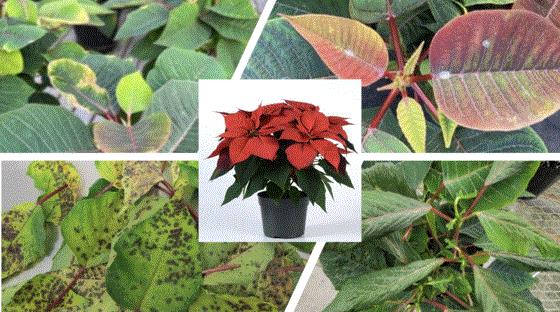
I mentioned potential challenges. The list is long. Diseases like root and stem rots, Botrytis, powdery mildew and more threaten to wipe out crops. Insects in all their life cycles seem to love poinsettias—whiteflies, thrips, fungus gnats, shoreflies, mites and a plethora of others. Nutritional disorders and deficiencies must be avoided because correction is challenging and costly. And you’re growing them in a crazy time of year, battling temperature swings, high light, your team’s summer vacations and a ton of other sub-optimal factors.
Yet poinsettias are a $200+ million crop in North America, and shoppers expect them sleeved up, racked or boxed, and available for purchase as soon as the smell of turkey is in the air. So, you grow them—year after year. And I share tips to help you produce them to the highest quality with the fewest losses—year after year.
I’m titling this week’s newsletter “Preventing Poinsettia Problems (PPP)” and sharing tips to prevent issues that arise every season. I went through a database of poinsettia problems that the Tech On Demand team has helped growers solve over the past five years and pulled out tech tips related to some of the most common early-season challenges.
After reading this newsletter, if you have time to pop in your AirPods and listen to a few podcasts, scroll on down to “Finish Line” where I list five good ones.

PPP #1: Avoid the Crud
If you walk into your poinsettia house and find little pools of whiteish goop or residue sitting on your bracts, you’ve got the crud. A more technical term for this disorder is “latex eruption.”
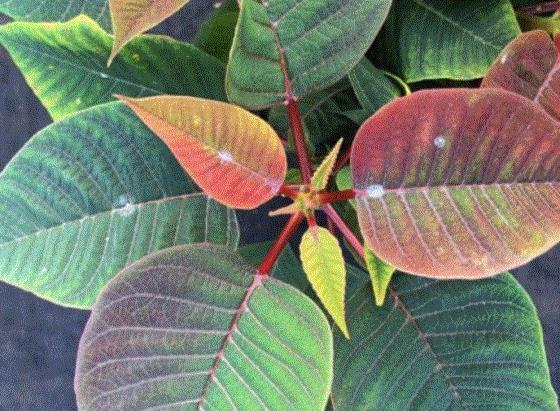
Most often, these blobs or puddles of latex-rich vascular fluid are found on the upper surface of bracts, along the midrib or larger veins. As it dries, it congeals and forms a crust that can look almost like a mealybug and almost always discolors the affected bract. Sooty mold also tends to grow on the residual vascular fluid, and it’s virtually impossible to rinse off.
Why does this disorder occur?
Turgor is the main culprit. Excessive turgor pressure causes cell walls in bracts and leaves to burst, and then vascular fluid erupts out of the plant. This occurs most often when growing media is overly wet going into the night or when nighttime air temperature is high.
Salt accumulation in the growing media can also be a factor in incidences and severity of latex eruption. Since plants aren’t growing rapidly at this point in the crop cycle but roots will still take up excess fertilizer salts in the media, additional salt uptake often forces roots to take up additional water to maintain osmotic balance. When excess moisture is present, this forced uptake may cause turgor pressure to increase and either cause or increase the severity of latex eruptions in your crop. Unfortunately, once latex eruption occurs, there is no way to undo the damage. Some varieties are more prone to this disorder than others, and incidences and severity of “crud” will vary from one operation to the next.
Since moisture management and temperature are the primary drivers for this disorder, occurrences are typically more severe in hot spots throughout your greenhouses or areas with poorer air flow. As such, it’s best to focus on prevention:
-
Allow moderate dry-down between waterings.
-
Increase airflow and air exchanges (when possible) during the daytime to help drive transpiration and shorten the time that media is saturated.
-
Avoid watering late in the day unless plants are dangerously dry and at risk of wilting. If moderate to severe damage occurs, it’s wise to apply a foliar fungicide, as damaged tissue provides an easy entry point for pathogens like Botrytis.

Nick’s Tip of the Week: PPP #2—Calcium Deficiency
Each week, I’ll work with my buddy Nick Flax, a technical services expert at Ball, to share a concern that’s come up during one of his numerous calls with growers across North America. This week, he’s sharing a tip that you might have seen before—as it’s an issue he works with growers to avoid or correct each year.
PROBLEM: I generally start hearing reports of calcium (Ca) deficiency on poinsettias late in the season. Many times, the growers I talk with haven’t seen the issue before and it tends to have snuck up on them. Hopefully, these tips will help you avoid this deficiency in 2025.
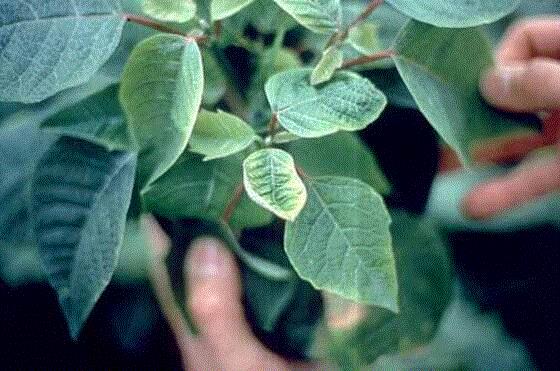
NICK’S TIP: Here are a few indicators of Ca deficiency to look out for, reasons why Ca deficiency might be popping up in your poinsettia crop, and strategies to help overcome this unsightly mineral nutrient deficiency.
What Causes Calcium Deficiency?
Some varieties are affected by Ca deficiency more severely and by different causes than others due to differences in physiology (genetics are funny that way ... ), so early symptoms will likely pop up on one or two varieties first. On a basic level, however, two things cause Ca deficiency in plants:
-
Not enough Ca is being supplied to or taken up by the crop
-
There is insufficient movement of Ca in your plants
In cases where supply or uptake is the limiting factor, too-low overall fertilizer rates, use of a fertilizer with too little Ca during fall and winter months, or an imbalanced Ca to magnesium (Mg) ratio (FYI—the ideal range is 3:1 to 5:1 Ca-to-Mg), often due to poor or changing water quality that has gone unmanaged.
Calcium only moves via bulk flow of water through plants. When environmental factors like sudden drops in air temperature, high relative humidity and lower light levels limit uptake of water and transpiration, the flow of Ca slows or stops in the plant.
How Do You Combat Ca Deficiency?
Close management of your fertilizer program is the first line of defense against supply/uptake-related Ca deficiency. To prevent or correct this group of causal agents, be sure to:
-
Pick a fertilizer suited for the crop, your growing environment, and the time of year. Some growers use all-purpose fertilizers or ones formulated with higher amounts of ammoniacal nitrogen (such as 20-10-20) to push early growth on poinsettias. However, unless additional Ca is added to your feed later on or you alternate with 15-0-15 (calcium nitrate), many all-purpose feeds will not provide enough Ca to your crop. Use a Cal-Mag type feed (17-5-17 or 15-5-15), a “cool-weather” feed, or fertilizers formulated for poinsettias (like Jack’s Poinsettia LX 20-5-19) to stay ahead of your crop’s Ca needs.
-
Properly mix your fertilizer to avoid accidental underfeeding, and always double-check your fertilizer injector’s calibration each time you mix up a new batch of feed. Remember that poinsettias are generally high feeders, so periodic feeding at about 300 ppm N or constant feed at 150 to 200 ppm is a good target for when plants are actively growing.
-
Get periodic irrigation water tests done if your water quality changes significantly throughout the year (especially if you use surface water). If your alkalinity is high, the chances of your Ca:Mg ratio becoming unbalanced if you pick the wrong fertilizer increases. Having a recent water quality report will help inform decisions on fertilizer selection or if you need to acidify your water before injecting fertilizer.
-
If lack of Ca movement in your plants is the most likely cause of deficiency symptoms, do what you can to modify the growing environment to increase water uptake and movement.
When temperatures begin to drop, transpiration will also drop and relative humidity levels in the greenhouse will increase. Be sure not to run your greenhouse air temperature too cool, and dehumidify during the day when possible while your plants are actively growing.
Adjust your greenhouse venting setpoints to avoid “crashing” too much cool air down on your crop and causing transpiration to grind to a halt. When the seasons start to turn—like between October and November—be sure to restrict how wide your vents can open when outdoor air temperatures are in the 50s F or below.
Increase air flow in your greenhouse, especially if venting/dehumidifying isn’t possible due to too-cold outdoor air temperatures. Add HAF fans if you have too few or make sure they are running more frequently. This can help drive transpiration and Ca movement even under adverse conditions.
If changing fertilizer and doing your best to manage the greenhouse environment still isn’t enough to prevent Ca deficiency, periodic foliar calcium chloride (CaCl) sprays may be your best option. Apply CaCl sprays at 200 to 400 ppm to “glisten” (not runoff) and be sure to mix in a wetting agent to ensure the solutions spreads out across the leaf surface.
Adding a wetting agent to the solution will enhance the rate of absorption and reduce the chances of phytotoxicity occurring. Weekly or bi-weekly sprays are appropriate, depending on the severity and frequency of the issue, but the goal should be to apply CaCl as few times as possible. Be sure to only use technical- or reagent-grade CaCl, as impurities in lower-grade CaCl can cause unrecoverable damage to your crops.

PPP #3: Summer Prop Heat Stress
When temperatures surge in summer, it’s crucial to leverage all available tools and resources to optimize growing conditions for your crops.
Poinsettia URCs tend to face severe heat stress during the dog days of summer. Here are some effective strategies to help your poinsettias (and garden mum transplants, too) thrive despite the heat.
Ensure the cuttings are cool when they arrive by checking the stem temperature with an infrared thermometer. (See LAST WEEK’S NEWSLETTER with tips for receiving hot poinsettia cuttings).
The main points include removing URC heat in the cooler as well as rehydrating them by dipping or utilizing a fog chamber. This ensures maximum stickability, root growth and uniformity of rooting.
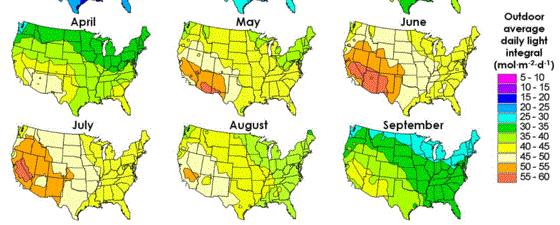
On the prop bench, use shadecloth and maintain visible water droplets on leaf surfaces for the first 10 days or until root initials are visible.
Research from NC State University indicates that black shadecloth providing low levels of shade (around 30% or less) offers minimal temperature reduction. The issue lies in black shadecloth’s tendency to absorb solar radiation, which then radiates heat downwards towards the crop—meaning lower-percentage shade affects light levels more than air temperature. While shading with black shadecloth may not reduce air temperature, it may still reduce leaf temperature.
Further studies from NC State indicate that reflective shade fabrics, such as those made from knit aluminum or reflective white materials, can reduce heat gain by up to 30%, thereby enhancing cooling efficiency. This research indicated that maximum reduction in heat was achieved with 60% shadecloth.
When using shadecloth, it’s important to consider the impact on light intensity. Daily light integral (DLI) maps for the U.S. show that most states receive 40 mols per day or more in June. The optimal light quantity for growth varies by species, but most floriculture crops thrive with a DLI of around 10 to 12 mols per day. According to Purdue Extension, garden mums require a minimum of 8 to 10 mols per day and high-quality mums are achieved with 18 mols per day or more. Therefore, reducing light intensity by 50-60% should not significantly impede growth.
During finishing, syringing is a method of cooling crops down with light water or mist applications. This helps cool the leaves without the risk of overwatering plants and saturating the substrate. Syringing can help to cool the leaves directly and through the process of evaporative cooling. NOTE: Avoid syringing too late in the day so the leaf surface can dry, because leaf wetness into the night will provide a conducive environment for disease. Depending on your location, humidity, and overhead structure, your cutoff point could be between 3 p.m. and 5 p.m.

PPP #4: Xanthomonas
One of the key poinsettia diseases to avoid in propagation is Xanthomonas. In a past issue of GrowerTalks, Margery Daughtrey, a senior extension associate at Cornell, covered this disease in detail. She discussed a handful of different greenhouse crops that often suffer from Xanthomonas, including poinsettias.
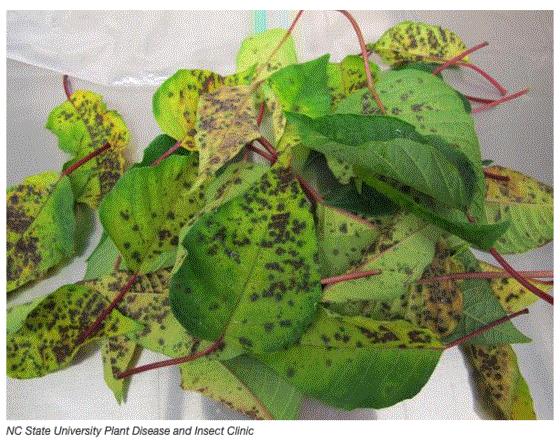
Here’s what Margery had to say:
Xanthomonas disease on poinsettias is especially problematic during propagation, as the environmental conditions (humidity, moisture and warmth) during this stage of a poinsettia’s production sequence are most conducive to bacterial infection and spread.
The vein-bounded leaf spots that Xanthomonas causes are disfiguring and are a trial for the finishing grower.
Putting a single name on the pathogen is difficult with poinsettia. Xanthomonas arboricola pv. poinsettiicola is the primary name in use, but other Xanthomonas species can be associated with poinsettia disease as well, as shown by research in Florida in 2015.
Meanwhile growers cope with disease management using the few tools at their disposal.
Margery also offers some potential management strategies:
-
Scout for symptoms in seed flats or young cutting-grown plants, which appear as miniature versions of symptoms on older plants. Mark and cordon off plants you suspect of having a Xanthomonas leaf spot, then get a lab verification of your suspicions before discarding plants—diseases are hard to diagnose with the eye alone.
-
Keep overhead irrigation to a minimum and time irrigation so that foliage dries before nightfall. Splashing spreads bacteria and quickly expands the zone of infected plants. Subirrigation isn’t safe for crops like geraniums that get a systemic Xanthomonas disease.
-
Utilize copper-based fungicides and Bacillus-based biocontrols to suppress the Xanthomonas diseases.
For much more on Xanthomonas in crops besides poinsettias, check out EXAMINING XANTHOMONAS.

PPP #5: Leaf Distortion
The Tech On Demand team talks to growers each year who see severe leaf deformation on their poinsettia crops, as seen in the photo below. Often, these growers have received cuttings in multiple shipments from multiple suppliers, so the source is impossible to pinpoint. Furthermore, the problem doesn’t affect all of the crop, sometimes it’s only a small percentage of plants.
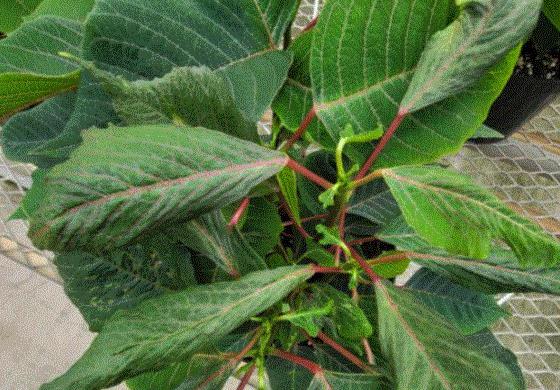
With summer heat, stress is often assumed to be the cause of the deformation. But soon, the affected plants begin aborting their hearts, and yet this doesn’t impact the entire pot, which is odd to say the least. When asking growers about symptoms, our team has heard that on some plants it was only affecting specific breaks, not the entire plant. So, it gets weirder … Insect levels usually aren’t out of range and all other levels seem normal. What’s the problem?
In the case of the photo above, the distorted foliage has a similar look to broad mite damage. However, with broad mites, we tend to see “dull” foliage. The plants can be sent to an insect lab to verify or rule out. What we have here is most likely phytotoxicity. There appears to be physical damage, “melted,” shiny, dull and with visible residues. This could be from something like a spreader sticker, tank mix incompatibility, disinfectant or possibly drift from outside the greenhouse.
Share this with your production team and make sure you’re staying on top of the chemicals used in your poinsettia production this year.

Finish Line … Poinsettia Podcasts

As I mentioned in the newsletter intro, we’ve released a number of Tech On Demand podcasts related to poinsettia production and insect/disease management. Below are direct links to the episodes on our podcast host, Podbean, but you can also find them on Apple Podcasts, Spotify and most of the other major apps.
SUCCESS WITH POINSETTIAS (PART 1)
Early-season tips—pH, EC, water management and more with Dr. Will Healy.
SUCCESS WITH POINSETTIAS (PART 2)
Transplant to finish (including height management, nutrition, pest monitoring and control) featuring Dr. Todd Cavins.
POINSETTIA INSECT CONTROL
Production with minimal common and less-common insect risk with Dr. Aaron Palmateer.
POINSETTIA DISEASE CONTROL
You can expect disease on poinsettias … but there are best practices to put in place to identify and control them, according to Dr. Palmateer.
A BIOLOGICAL APPROACH TO FALL IPM
The main poinsettia pests require diligent scouting and early preventative controls. Phil Gerry shares a bio-IPM plan for your crop.
SAFELY MANAGING WHITEFLY (AND MORE)
Insect and mite pests are some of the most damaging to poinsettias. Broch Martindale has some potential controls and solutions to consider.
Talk to you next week!



Please feel free to send your comments, constructive criticism and topic ideas to me at bcalkins@ballhort.com.

Bill Calkins
Editor - Tech On Demand
This email was received by you and 25,561 other fine subscribers!
If you're interested in advertising in Tech On Demand, contact Kim Brown ASAP and she'll hook you up.